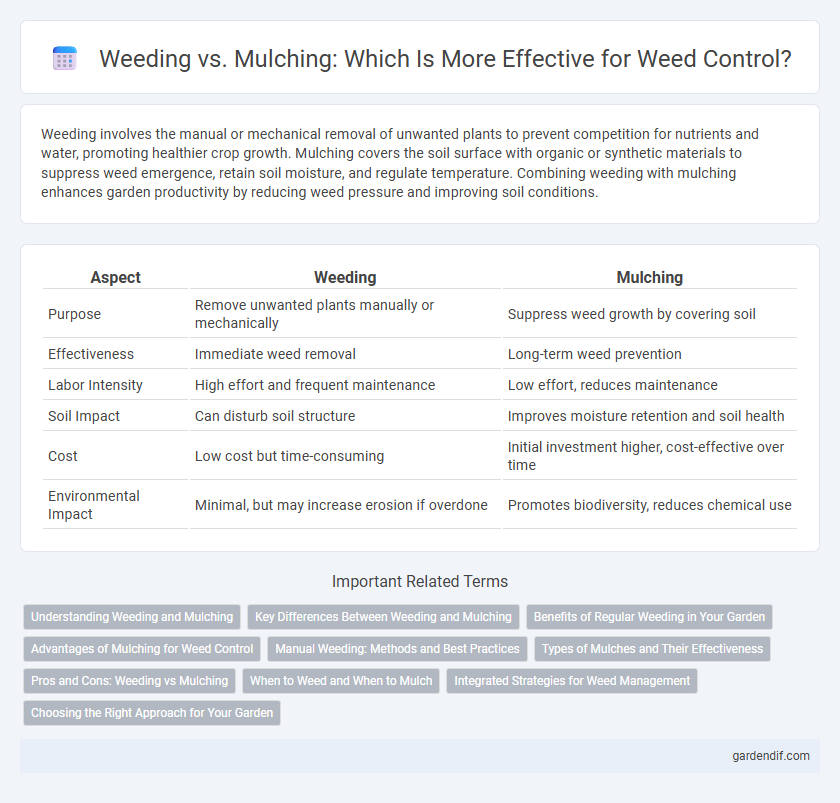
Weeding vs Mulching Illustration
Weeding involves the manual or mechanical removal of unwanted plants to prevent competition for nutrients and water, promoting healthier crop growth. Mulching covers the soil surface with organic or synthetic materials to suppress weed emergence, retain soil moisture, and regulate temperature. Combining weeding with mulching enhances garden productivity by reducing weed pressure and improving soil conditions.
Table of Comparison
| Aspect | Weeding | Mulching |
|---|---|---|
| Purpose | Remove unwanted plants manually or mechanically | Suppress weed growth by covering soil |
| Effectiveness | Immediate weed removal | Long-term weed prevention |
| Labor Intensity | High effort and frequent maintenance | Low effort, reduces maintenance |
| Soil Impact | Can disturb soil structure | Improves moisture retention and soil health |
| Cost | Low cost but time-consuming | Initial investment higher, cost-effective over time |
| Environmental Impact | Minimal, but may increase erosion if overdone | Promotes biodiversity, reduces chemical use |
Understanding Weeding and Mulching
Weeding involves the manual or chemical removal of unwanted plants to prevent competition for nutrients, water, and sunlight, ensuring optimal growth for desired crops or garden plants. Mulching, on the other hand, uses organic or synthetic materials spread over soil surfaces to suppress weed growth, retain moisture, and regulate soil temperature. Effective weed management often combines both techniques to enhance plant health and reduce maintenance efforts.
Key Differences Between Weeding and Mulching
Weeding involves the direct removal of unwanted plants to prevent competition for nutrients and sunlight, while mulching refers to covering soil with organic or inorganic materials to suppress weed growth and retain moisture. Weeding provides immediate elimination of weeds but requires repeated effort, whereas mulching offers a preventive barrier that reduces weed emergence and enhances soil health over time. Both practices are essential in integrated weed management, with mulching complementing weeding by minimizing weed seed germination and improving garden sustainability.
Benefits of Regular Weeding in Your Garden
Regular weeding enhances garden health by preventing invasive plants from competing for nutrients, water, and sunlight, promoting stronger growth of desired plants. It reduces pest infestations and disease spread by removing weed habitats and minimizing plant stress. Consistent weeding improves soil aeration and composition, facilitating better root development and nutrient absorption.
Advantages of Mulching for Weed Control
Mulching suppresses weed growth by blocking sunlight, creating an inhospitable environment for weed seeds to germinate. Organic mulches like wood chips and straw improve soil health by retaining moisture and adding nutrients as they decompose. This method reduces the need for chemical herbicides, promoting sustainable and eco-friendly garden management.
Manual Weeding: Methods and Best Practices
Manual weeding involves physically removing weeds by hand or using handheld tools such as hoes and weeders to target unwanted plants without disturbing surrounding crops. Best practices include frequent weeding sessions to prevent weed seed maturity, working when the soil is moist for easier root removal, and disposing of weeds properly to avoid reseeding. Combining manual weeding with mulching enhances weed control by blocking sunlight and reducing weed regrowth.
Types of Mulches and Their Effectiveness
Organic mulches such as wood chips, straw, and compost improve soil fertility and suppress weeds by blocking sunlight, making them highly effective for long-term weed control. Inorganic mulches like landscape fabric and plastic sheeting create a physical barrier that prevents weed growth but do not enhance soil health. Selecting the appropriate mulch type depends on the specific garden needs, with organic mulches offering added benefits for soil moisture retention and microbial activity.
Pros and Cons: Weeding vs Mulching
Weeding removes unwanted plants manually or chemically, providing immediate control but requiring frequent maintenance and risking soil disturbance. Mulching suppresses weed growth by blocking sunlight, conserving soil moisture, and improving soil health, though it can be costly and may harbor pests if not managed properly. Combining both methods can optimize garden health by reducing weed pressure while enhancing soil conditions.
When to Weed and When to Mulch
Weeding is most effective during early plant growth stages when weeds are small and easier to remove, preventing competition for nutrients and sunlight. Mulching is best applied after weeding to suppress future weed growth, retain soil moisture, and regulate temperature. Timing mulch application properly enhances soil health and reduces the need for frequent manual weeding.
Integrated Strategies for Weed Management
Combining weeding and mulching creates an integrated weed management approach that enhances garden health and decreases herbicide dependency. Manual or mechanical weeding effectively removes established weeds, while organic mulches like wood chips or straw suppress new weed growth and improve soil moisture retention. Implementing these strategies together supports sustainable weed control by reducing competition for nutrients and promoting beneficial soil microorganisms.
Choosing the Right Approach for Your Garden
Effective garden management relies on choosing between weeding and mulching based on specific plant needs and soil conditions. Weeding manually removes unwanted plants to prevent competition for nutrients, while mulching suppresses weed growth by blocking sunlight and retaining soil moisture. Understanding your garden's weed pressure and plant tolerance guides the right approach for healthier growth and sustainable maintenance.
Weeding vs Mulching Infographic

 gardendif.com
gardendif.com